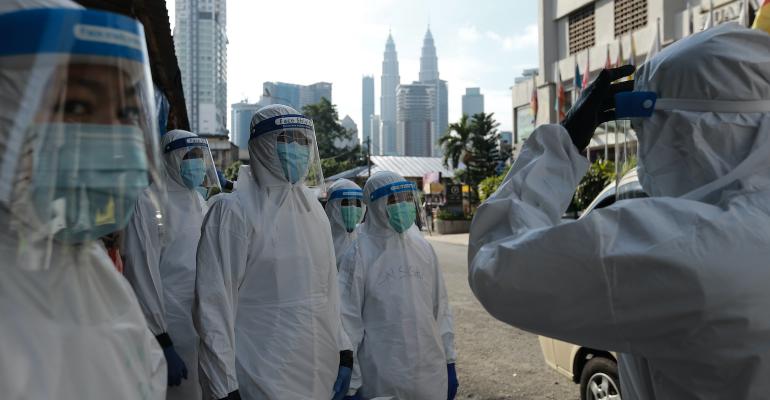The most important part of molecular detection is the quality of the RNA, which means a compromised quality will lead to a lower possibility to detect SARS-CoV-2, said Professor Vip Viprakasit, MD, DPhil (Oxon) & Warut Tulalumba, CEO & Founder of AtGenes Co. Hence, they use the Biosafety Mobile Unit in Thailand.
In his session on Molecular Detection of the SAR-CoV2 for Pandemic Control of COVID-19 through Active Case Finding on day three of Medlab Asia & Asia Health, Dr. Viprakasit said that the SARS-CoV- 2 virus, which is a RNA virus, can only be detected after the inoculation period. The virus can only be detected using molecular technique as it has a unique sequence that distinguishes it from other coronaviruses.
Through his presentation he explained the RT-PCR testing process, which is widely used globally. PCR - polymerase chain reaction - is used to detect genetic material from a virus.
The nasal swab has proved the best technique to detect the virus. The sample must be stored at 2-8 degrees Celsius for up to 3 days before the RNA extraction, deactivate the virus then perform the RNA extraction. Then a PCR test is used. “We select different regions, especially the N genes of the virus which is very important,” said Dr. Viprakasit.
To get the N genes, they have to amplify some regions such as the ORF, he explained
Another technology used is Point of Care (PoC) Molecular testing which is easier than the RT-PCR, they collect the sample and put it into the machine and have it run which means less humans handling the virus. PoC can help detect 22 other viruses such as Influenza A, Influenza B. The results can be available within two hours.
COVID-19 and its impact on blood
During her session Updates on COVID-19 and Haematology, Dr Veena Selvaratnam, Haematologist at Ampang Hospital, Malaysia, said patients develop profound hypnoemiza early in the disease. Patients could get endothelial activation due to proinflammatory and procoagulant and proliferative state which then lead to endothelial damage.
“When there is a destruction of the cells, there is activation of the endothelial therefore release of leukocytes and monocytes,” she explains; hence, it promotes thrombin generation.
“COVID-19 is a very prothrombotic condition and this is due to the damage that happens in the vascular bed,” she said.
She explained that with a common full blood count, the majority of patients have lymphopenia (35%-83%) more lower ALC in severe disease, reduction in both CD4 and CD8 T cells; much lower CD8.
Patients also show mild neutrophilia will have higher neutrophil in which lymphocyte ratio in more severe disease or ICU admissions. They can also have mild thrombocy.
Patients have reactive and plasmacytoid lymphocytes and that's because it's a viral disease. She explained further that in very severe cases, patients can also have Hemophagocytosis.
“One third of infected patients and 50 percent of autopsy cases have thrombosis,” she said. Thrombosis is associated with risk of mortality and morbidity; however, we still do not have a number on thrombosis effect on death. There are different factors on developing thrombosis, she explains that anticoagulation is important to prevent thrombosis.
One of the most consistent findings on whether a patient will develop thrombosis or not is that of a higher D-dimer level. There are two types of D-dimer, each reporting different assays. Patients with COVID-19 most certainly have a higher D-dimer level. She explains that D-dimer method comparison is based on assays on the same samples, adding that low D-dimer were observed in patients on anticoagulation with COVID-19.
In the panel session Impact of the COVID-19 pandemic on supply and the use of blood for transfusion in South East Asia, Pawinee Kupatawintu, Deputy Director of the National Blood Centre in Thailand, said due to the pandemic, the donation of blood has decreased by 30 percent which led them to create donation strategies to ensure donations while ensuring donor safety.
“The blood requests from hospitals have decreased but since June 2021 it has come back to normal demand which led to shortages again,” she said. During shortages such as in April and August 2021, the National Blood Centre announced the shortages to the public which led blood donations to increase again.
On the same panel, Dr Chanthala Souksakhone, Director, National Blood Transfusion Center, Laos, said the number of blood donors increases year by year; however, during the end of 2019, 2020, and now they have seen a negative impact on blood collection due to the pandemic.
Both speakers said that they are having campaigns through mass media, social networks to ask the public to donate blood.
“We sent letters to all central and provincial hospitals about the blood stock shortage to coordinate to deal with emergency cases,” he explained.
Blood donation; however, faces other challenges not just shortages, such as those who have COVID-19 and those who have had the vaccination. Kupatawintu said they change the criteria such as those who had the vaccine must wait for 7 days. She added that donors need to inform them if there is a risk of COVID-19 infection within 7 days after donation. She explained that they also check the antibody in the donors.
Dr Chanthala also said that they think about COVID-19 infection and vaccination. “We have to ask them if they have the risk.”

